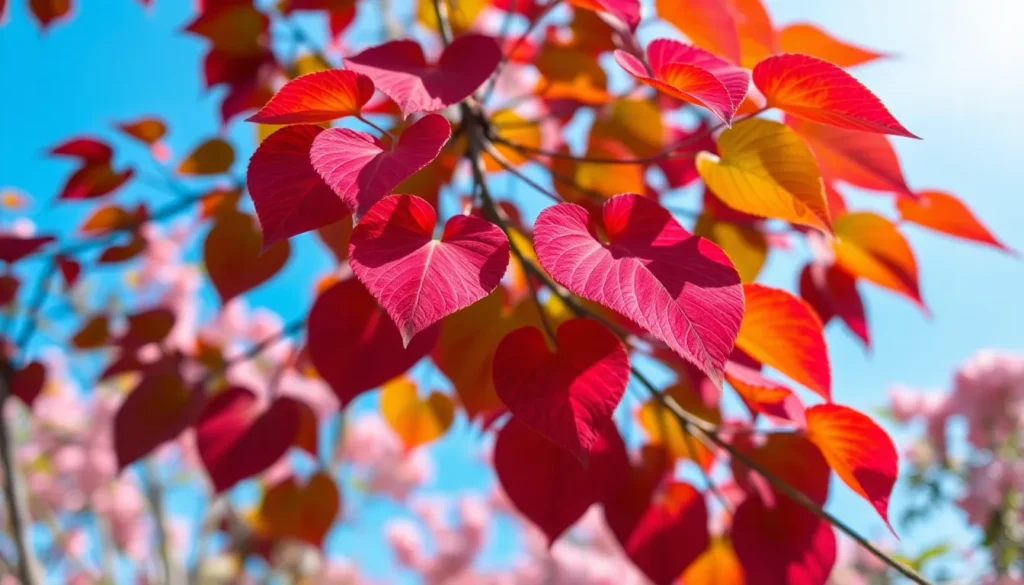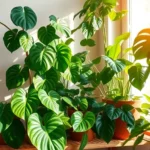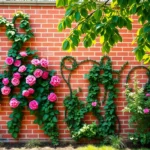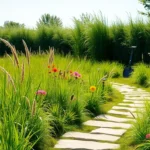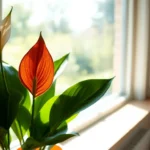Nature has a beautiful way of capturing our hearts — literally! Trees with heart-shaped leaves create some of the most romantic and visually stunning landscapes we’ll ever encounter. These enchanting species don’t just symbolize love and affection; they’re also incredibly diverse and offer unique benefits to any garden or natural setting.
From the majestic redbud tree that bursts with pink blooms in spring to the charming catalpa with its oversized heart leaves we’re about to explore some of nature’s most lovable specimens. Whether you’re planning a romantic garden theme or simply want to add unique character to your industry these heart-leafed beauties deliver both visual appeal and ecological value.
We’ve compiled the most stunning heart-shaped leaf trees that’ll transform your outdoor space into a living valentine. Each species brings its own personality charm and growing requirements — making it easy to find the perfect match for your exact needs and climate zone.
Eastern Redbud (Cercis canadensis)
We consider the Eastern Redbud one of nature’s most romantic specimens, perfectly embodying the heart-shaped leaf beauty we’re exploring. This native North American treasure offers gardeners an ideal combination of distinctive foliage and stunning spring displays.
Heart-Shaped Foliage Characteristics
Eastern Redbud leaves showcase perfectly symmetrical heart shapes that measure 3 to 5 inches across at maturity. The foliage emerges with a reddish purple tint in early spring before transitioning to bright green throughout the growing season. Each leaf displays smooth edges and a distinctive pointed tip that creates the classic valentine silhouette we all recognize.
We notice the leaves arrange themselves alternately along the branches, creating an elegant layered appearance that maximizes sunlight exposure. The heart-shaped design isn’t just aesthetically pleasing—it’s functionally efficient for photosynthesis. Young leaves often display bronze coloring that gradually develops into the mature green shade.
Growing Conditions and Care Requirements
Eastern Redbuds thrive in USDA hardiness zones 4 through 9, making them adaptable to most temperate climates across the United States. We recommend planting them in well-draining soil with a pH between 6.0 and 7.5 for optimal growth. These trees prefer partial shade to full sun exposure, requiring at least 4 hours of direct sunlight daily.
Watering needs remain moderate once established, typically requiring 1 inch of water per week during dry periods. We suggest mulching around the base to retain moisture and regulate soil temperature. Eastern Redbuds reach mature heights of 20 to 30 feet with similar spreads, making them perfect for medium-sized landscapes.
Seasonal Color Changes and Flowering
Spring brings the most spectacular display when Eastern Redbuds produce clusters of small pink or purple flowers directly from their branches and trunk. We observe this unique flowering pattern called cauliflory, where blooms appear before the heart-shaped leaves emerge. The flowering period typically lasts 2 to 3 weeks in early spring.
Summer showcases the full glory of the heart-shaped foliage in vibrant green tones that provide excellent shade coverage. Fall transforms the leaves into brilliant yellow hues that create stunning autumn displays. We appreciate how the seasonal progression offers year-round interest, from bare winter branches to spring blooms to summer shade to autumn color.
Catalpa Tree (Catalpa bignonioides)
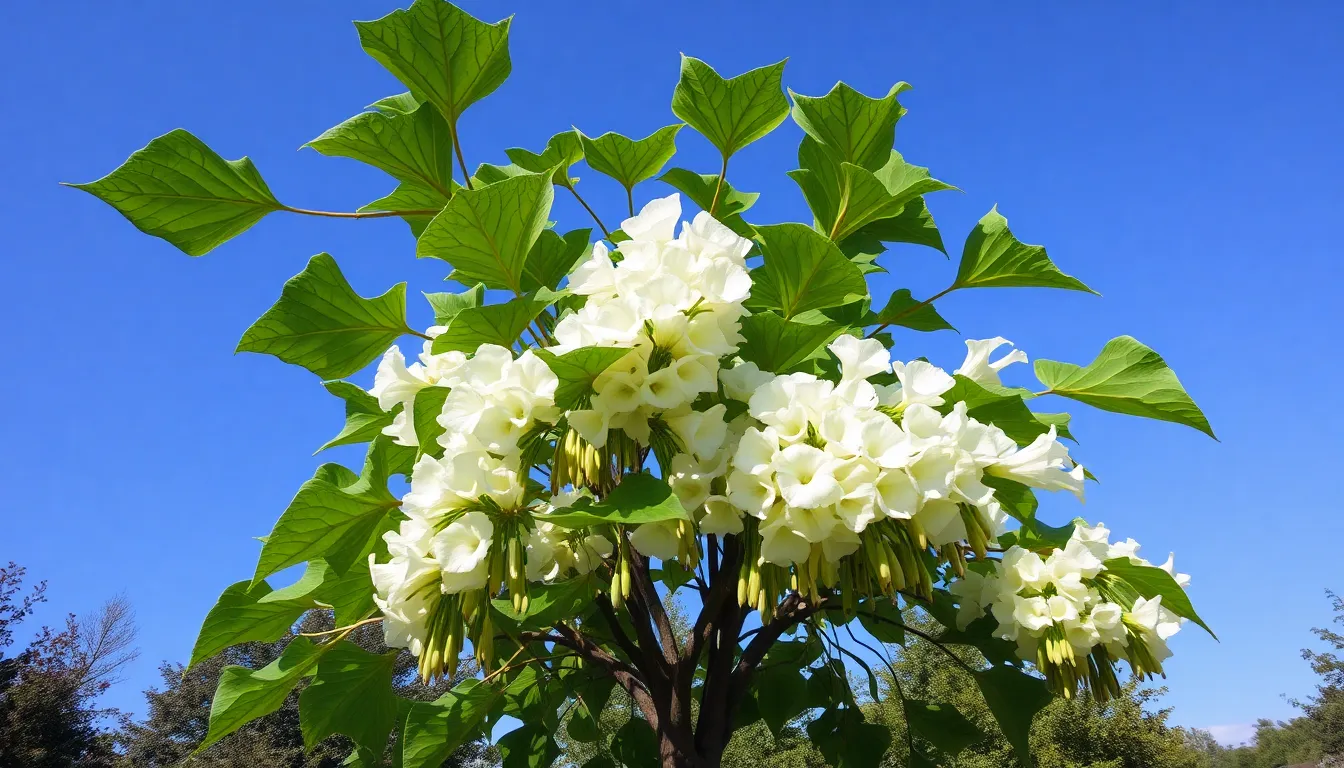
Catalpa trees stand out as magnificent specimens that perfectly complement the romantic charm of Eastern Redbuds. We’ll explore how these distinctive trees offer their own unique heart shaped beauty with impressive scale and seasonal drama.
Distinctive Large Heart Leaves
Massive heart shaped foliage makes Catalpa bignonioides one of nature’s most dramatic displays. We find these leaves growing up to 12 inches long and 8 inches wide, creating a bold statement that dwarfs most other heart leafed varieties. Each leaf showcases the classic heart silhouette with a pronounced point and gentle curves that catch sunlight beautifully throughout the growing season.
Size comparison reveals just how impressive these leaves truly are compared to other heart shaped species. While Eastern Redbud leaves measure 3 to 5 inches across, Catalpa leaves can be nearly three times larger, providing substantial shade coverage. The leaves emerge bright green in spring and maintain their vibrant color through summer before turning yellow in fall.
White Trumpet Shaped Flowers
Spectacular white blooms transform Catalpa trees into stunning focal points during late spring flowering season. We observe these trumpet shaped flowers clustering together in large panicles that can reach 8 to 10 inches long, creating dramatic vertical displays against the heart shaped leaf backdrop. Each individual flower measures about 2 inches across with distinctive purple spots and yellow markings inside the throat.
Flowering timing typically occurs in May or June, providing an extended blooming period that lasts 2 to 3 weeks. The fragrant blossoms attract hummingbirds, bees, and butterflies, making Catalpas excellent choices for wildlife gardens. These flowers appear after the heart shaped leaves have fully emerged, creating a beautiful contrast between the white blooms and green foliage.
Long Seed Pods and Winter Interest
Extended seed pods develop throughout summer following the spectacular flower display, eventually reaching 8 to 20 inches in length. We notice these slender pods hanging like decorative ornaments from the branches, earning Catalpas the nickname “cigar tree” or “Indian bean tree.” The pods start green and gradually turn brown as they mature through fall.
Winter architectural value comes from these persistent seed pods that remain attached through the dormant season. Even after the heart shaped leaves drop, the long pods continue providing visual interest against winter skies. The pods eventually split open to release many small seeds with papery wings, though many gardeners appreciate leaving them intact for their ornamental value throughout the colder months.
American Basswood (Tilia americana)
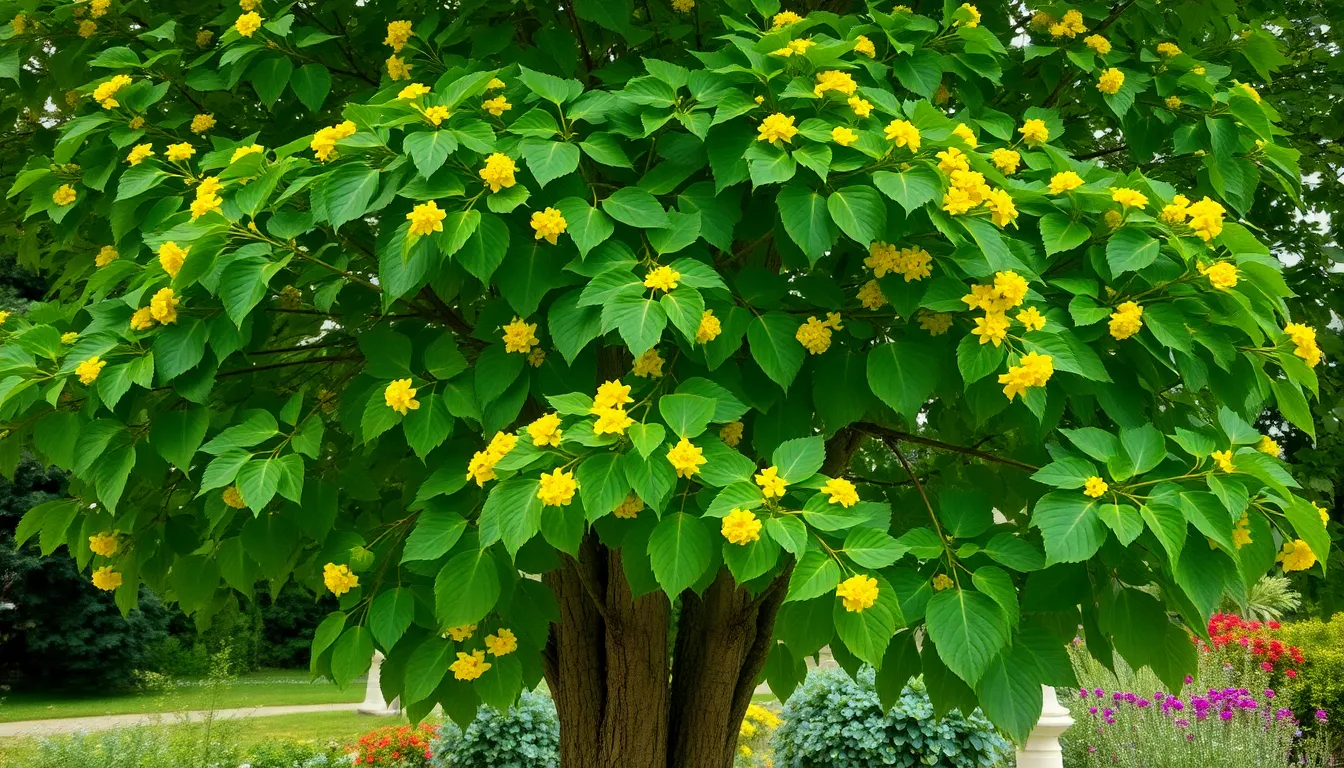
American Basswood stands out among heart leafed trees with its distinctive asymmetrical foliage and impressive stature. This North American native creates a stunning specimen that reaches 60 to 80 feet tall and spreads 30 to 60 feet wide.
Asymmetrical Heart-Shaped Leaves
Asymmetrical heart shaped leaves make American Basswood instantly recognizable in any industry setting. The ovate to cordate leaves typically measure 4 to 6 inches long but can grow up to 10 inches on mature specimens. Each leaf features a coarsely serrated margin that creates textural interest throughout the growing season.
What sets these leaves apart from other heart shaped varieties is their distinctly uneven base. The long petiole supports each leaf’s unique asymmetrical form, giving the tree a naturally organic appearance. We’ve observed how this characteristic creates beautiful dappled shade patterns beneath established trees.
Fragrant Summer Blooms
Fragrant yellow flowers bloom in June, filling the air with their sweet perfume that attracts beneficial insects from great distances. These small but many blossoms cluster together in drooping cymes that dangle gracefully from the branches. The timing of these blooms perfectly complements the mature heart shaped foliage.
Following the flowering period, somewhat sweet and mucilaginous fruits develop that provide additional wildlife value. The fragrance from American Basswood flowers is so distinctive that beekeepers specifically seek out these trees for honey production. We recommend planting this species where you can fully appreciate its aromatic qualities during the summer months.
Wildlife and Pollinator Benefits
Wildlife benefits from American Basswood extend far beyond its nectar rich flowers that support local bee populations. Songbirds and blue jays regularly visit these trees for both food sources and nesting sites. The dense branching structure provides excellent shelter for various bird species throughout the year.
Pollinators particularly value the abundant nectar that contributes significantly to regional honey production. The tree’s ecological role as both a specimen and shade provider makes it ideal for parks and residential areas where wildlife habitat is desired. We’ve noticed how American Basswood consistently attracts more diverse wildlife than many other native species in similar growing conditions.
Paw Paw Tree (Asimina triloba)
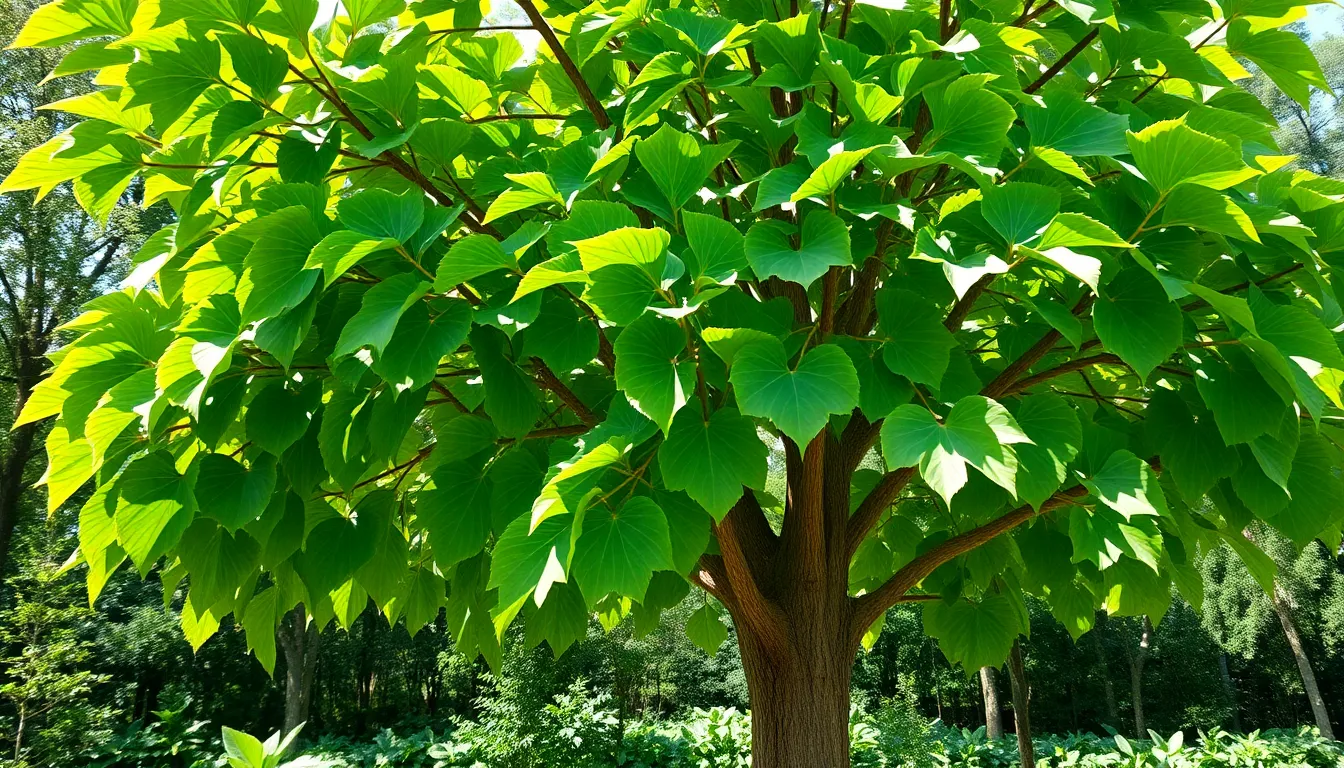
Moving beyond traditional ornamental trees, we discover the Paw Paw tree offers both striking heart shaped foliage and delicious fruit rewards. This native North American species stands out with its exotic appearance even though being perfectly suited to temperate climates.
Tropical-Looking Heart Foliage
Large heart shaped leaves create an almost subtropical atmosphere in our gardens, measuring significantly larger than other heart leafed varieties. The foliage displays a dark green color throughout the growing season, arranged alternately along branches to maximize visual impact. Each leaf showcases the classic heart shape with prominent veining that adds textural interest to the canopy.
Lush tropical appearance makes the Paw Paw an unexpected focal point in temperate landscapes where most trees don’t provide such exotic character. The leaves emerge in spring with a fresh green hue and maintain their vibrant color well into fall. Unlike many native species, this tree’s foliage creates dense shade coverage perfect for understory plantings.
Edible Fruit Production
Custard apple flavor describes the unique taste of Paw Paw fruit, combining banana and mango notes in what’s considered America’s largest native edible fruit. The fruit typically ripens in late summer to early fall, providing fresh eating opportunities right from our own trees. Each fruit contains multiple large seeds surrounded by creamy, nutritious flesh that wildlife and humans both enjoy.
Largest native fruit in the United States makes the Paw Paw particularly valuable for sustainable food forestry and permaculture designs. Fruit production requires cross pollination between different trees, so we recommend planting at least two specimens for optimal harvest yields. The fruits don’t store well fresh but can be processed into ice cream, smoothies, and baked goods.
Native Habitat Preferences
USDA hardiness zones 5 to 8 accommodate Paw Paw trees across much of the eastern United States where they naturally occur in understory environments. The tree thrives in moist, well drained, fertile soils typically found along streams and in floodplains. Shade tolerance when young allows for woodland garden integration, though partial to full sunlight encourages better fruit production.
Reaching 15 to 30 feet in mature height, Paw Paw trees develop a pyramidal shape during youth before spreading into rounded canopies with age. The trees prefer consistent moisture without waterlogged conditions, making them excellent choices for riparian restoration projects. Their natural woodland habitat preferences make them perfect companions for other native understory plants in naturalized industry designs.
Katsura Tree (Cercidiphyllum japonicum)
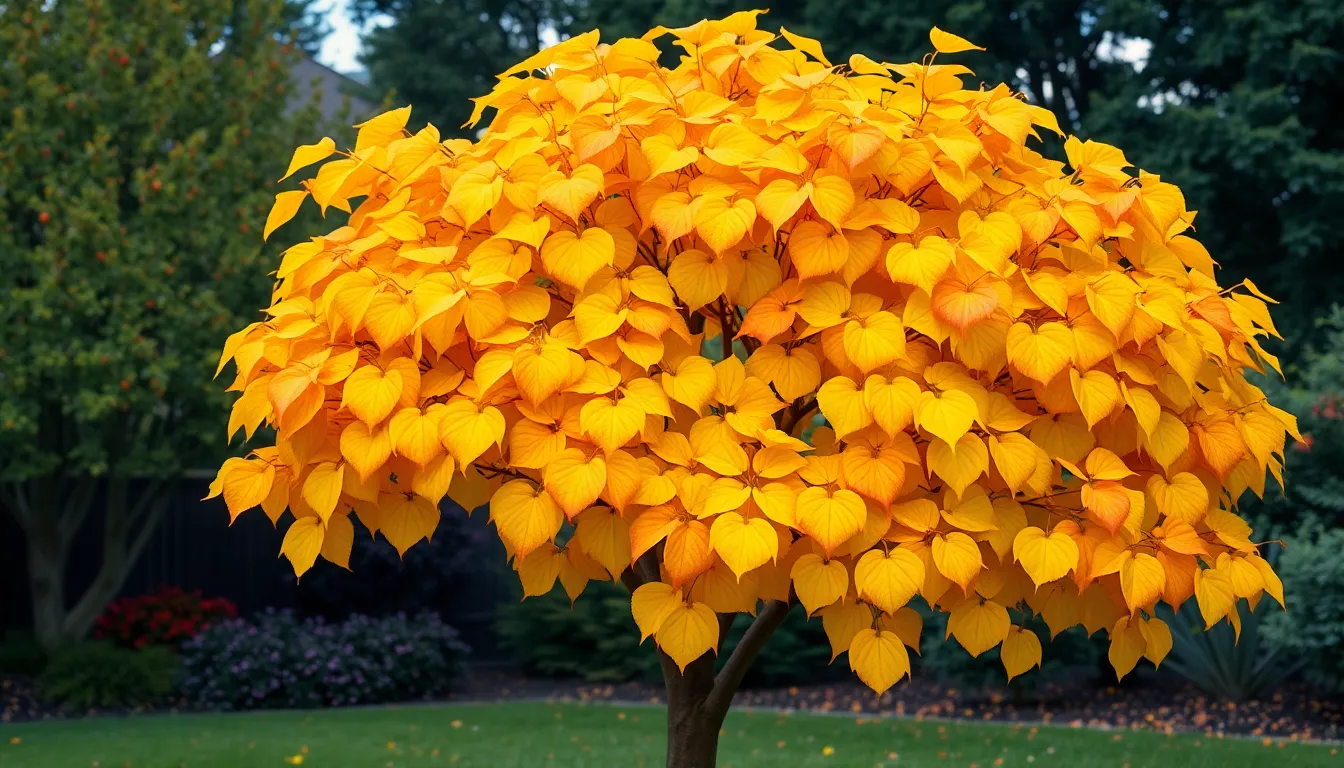
We’re excited to showcase another stunning addition to our heart-leafed tree collection. The Katsura tree stands out as one of the most elegant specimens with its remarkable symmetrical foliage and unique seasonal characteristics.
Perfectly Symmetrical Heart Leaves
Perfectly shaped heart leaves make the Katsura tree a true standout among ornamental species. We observe these leaves displaying flawless symmetry that surpasses even the beloved redbud varieties. Each leaf measures approximately 2 to 4 inches across with smooth, rounded edges that create the classic heart silhouette. The foliage emerges in pairs along delicate branches, creating a refined canopy that filters sunlight beautifully. During the growing season, these leaves maintain their pristine heart shape while providing excellent shade coverage for smaller garden plants beneath.
Fall Color Transformation
Dramatic color changes transform the Katsura tree into autumn’s most spectacular performer. We witness these heart-shaped leaves shifting from their summer green to brilliant combinations of yellow, orange, and apricot hues. The transformation occurs gradually, allowing us to enjoy weeks of stunning fall display. Unlike many other heart-leafed species, the Katsura’s color change is particularly vibrant and consistent throughout the entire canopy. This reliable autumn show makes it an excellent choice for seasonal interest in our landscapes.
Sweet Cotton Candy Fragrance
Sweet cotton candy scents accompany the Katsura tree’s fall color display, creating a truly magical experience. We notice this distinctive fragrance becomes most pronounced as the leaves begin their autumn transformation. The sugary aroma carries on gentle breezes, often detectable from several feet away from the tree. This unique characteristic sets the Katsura apart from other heart-leafed varieties, as most trees don’t offer such pleasant olfactory experiences. The combination of visual beauty and sweet fragrance makes the Katsura tree an exceptional choice for areas where we spend time relaxing or entertaining outdoors.
Black Walnut (Juglans nigra)
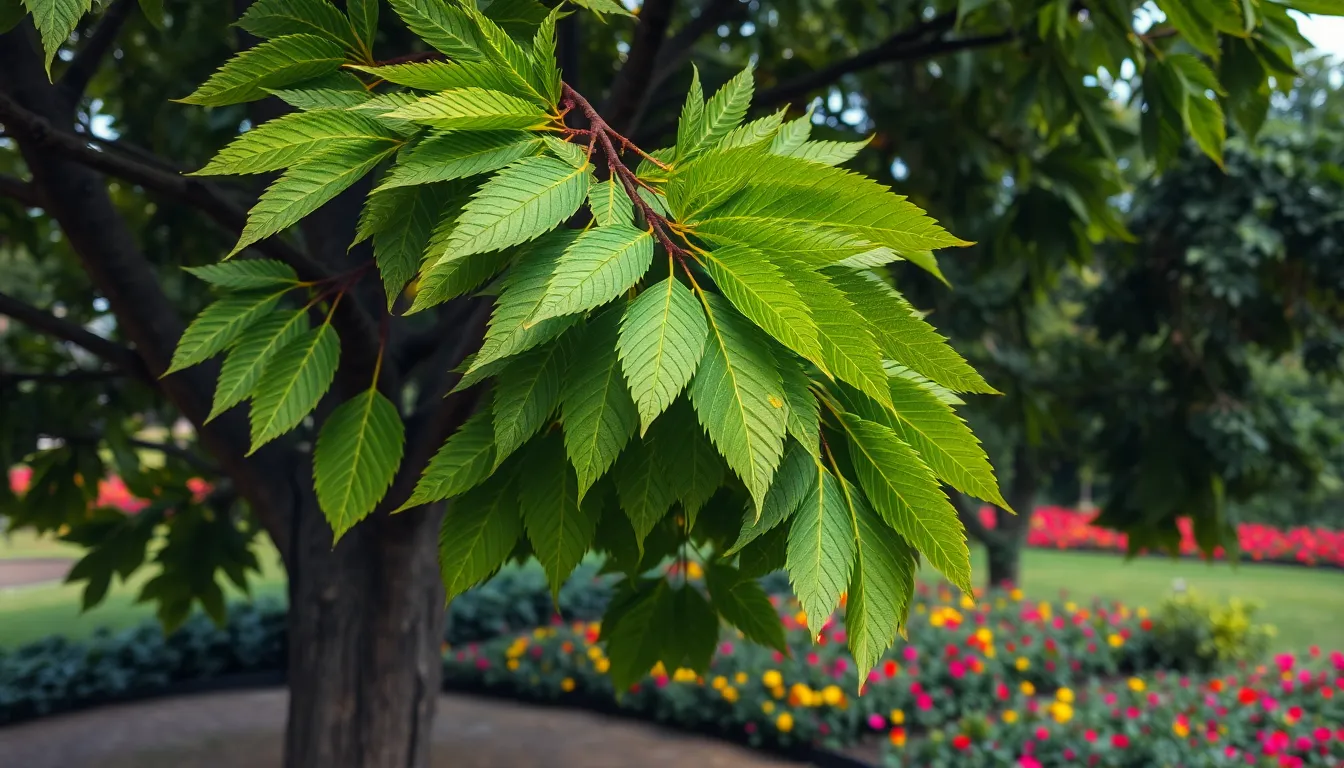
Black walnut trees distinguish themselves from other heart leafed species through their unique leaf structure and exceptional characteristics. We often find these majestic trees misunderstood when it comes to their foliage shape.
Compound Heart-Shaped Leaflets
Black walnut trees feature alternate compound leaves with 11 to 23 lanceolate leaflets rather than traditional heart shaped leaves. We notice the leaflets themselves aren’t heart shaped, but the overall compound structure creates visual interest in landscapes. The heart shaped appearance actually comes from the leaf scars on black walnut twigs, which resemble a monkey’s face with three distinctive bundle scars. These leaf scars remain visible after the leaves drop, providing winter identification features for tree enthusiasts. Gardeners appreciate this unique characteristic that sets black walnuts apart from true heart leafed varieties like redbuds and catalpas.
Valuable Timber Properties
Black walnut timber ranks among the most prized hardwoods in North America for its exceptional qualities. We value this wood for its remarkable strength, outstanding durability, and stunning grain patterns that make it ideal for high end furniture making. Woodworkers consistently choose black walnut for premium cabinetry, gunstocks, and decorative veneers due to its workability and rich chocolate brown heartwood. The timber’s natural resistance to decay and insects adds to its commercial appeal in the lumber industry. Mature black walnut trees can command thousands of dollars from timber buyers, making them valuable long term investments for property owners.
Allelopathic Soil Effects
Black walnut trees produce juglone, a powerful chemical compound that significantly impacts surrounding soil and plant life. We observe this allelopathic effect through the roots, leaves, and husks that release juglone into the soil environment. The chemical prevents many plants from growing within the tree’s root zone, affecting garden planning and industry design decisions. Tomatoes, potatoes, peppers, and many other vegetables show sensitivity to juglone exposure, making companion planting challenging near black walnuts. This natural herbicidal effect reduces biodiversity in the immediate area but creates unique ecological niches that some native plants have adapted to tolerate.
Kentucky Coffee Tree (Gymnocladus dioicus)
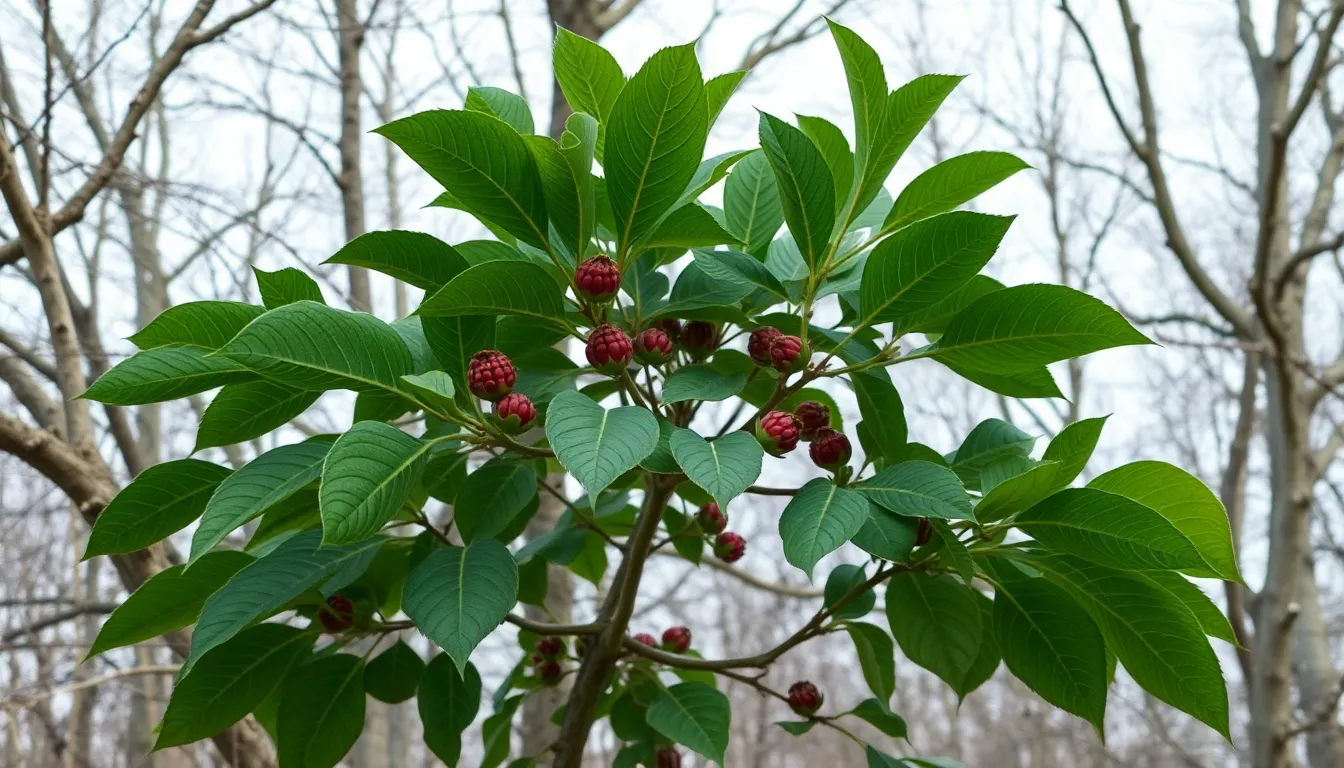
We encounter a fascinating species that breaks the traditional mold of heart shaped leaf trees while still offering remarkable industry appeal. The Kentucky Coffee Tree stands out with its distinctive compound foliage structure and impressive architectural presence.
Double-Compound Heart Leaves
Kentucky Coffee Trees feature bipinnately compound leaves that create an entirely different visual experience from simple heart shaped foliage. These massive leaves reach up to 3 feet long and 2 feet wide, comprising 5 to 9 pairs of leaflets arranged in a complex pattern. Each leaf emerges with a striking pinkish bronze color before transitioning to a beautiful bluish green during the growing season.
We notice the tree’s most interesting heart connection appears in its leaf scars rather than the leaves themselves. After the leaves drop, the zigzag stem pattern reveals perfectly heart shaped leaf scars that remain visible throughout winter. This unique characteristic provides year round interest even when the tree stands bare.
Unique Bark Texture and Pattern
The bark of Kentucky Coffee Trees displays a dull grayish brown color with deep fissures and distinctive scaly ridges. We observe similarities to black cherry bark in its texture and overall appearance. These pronounced ridges create dramatic shadows and visual depth that adds architectural interest to winter landscapes.
Mature specimens develop increasingly complex bark patterns as they age, with the fissures becoming more pronounced and the scaly texture more defined. The bark’s rugged appearance perfectly complements the tree’s bold structural form and winter silhouette.
Large Seed Pod Characteristics
Female Kentucky Coffee Trees produce impressive seed pods that measure up to 10 inches long and 1 to 3 inches wide. These pods display rich purplish brown to reddish brown coloration that creates striking visual contrast against the tree’s foliage and bark.
We find these substantial pods particularly noteworthy for their persistence, often remaining attached well into winter months. The pods add important ornamental value and serve as excellent identification features for this remarkable species. Their size and color make them conversation pieces in any industry setting where these slow to moderately growing trees reach their mature height of 60 to 80 feet.
Forest Pansy Redbud (Cercis canadensis ‘Forest Pansy’)
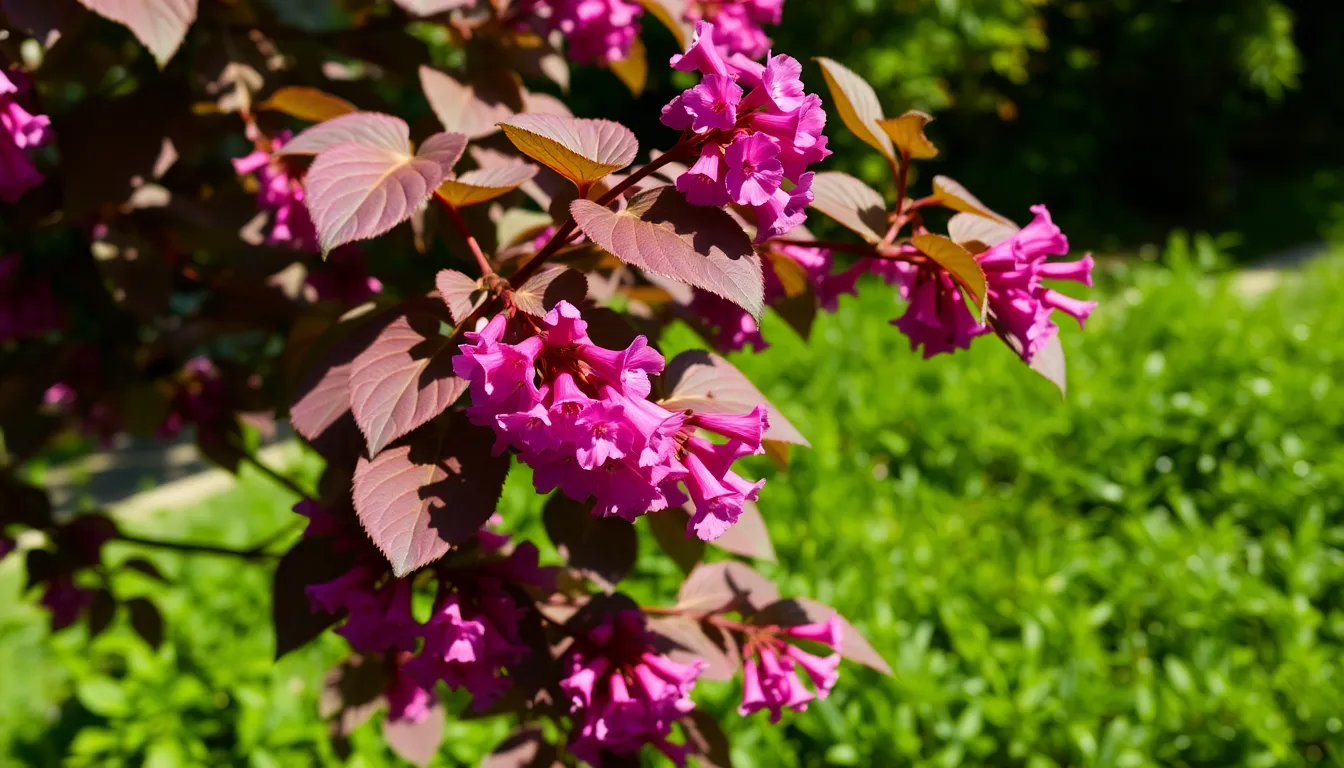
Building on the charm of Eastern Redbuds, we introduce the Forest Pansy cultivar, which elevates heart shaped leaf beauty with its stunning purple foliage. This remarkable variety transforms traditional redbud appeal into something truly extraordinary.
Purple Heart Shaped Foliage
Purple foliage creates the most striking feature of Forest Pansy Redbuds, with leaves displaying glossy red purple coloration when young. Maturing gradually, these heart shaped leaves transition to deeper purple or maroon shades throughout the growing season. Summer months bring subtle changes as the foliage may shift to purple green or dark green tones, maintaining visual interest across seasons.
Leaf structure mirrors the classic heart shape we love in standard redbuds, but the color intensity sets this cultivar apart from other heart leafed varieties. Growing approximately 3 to 5 inches across like their Eastern Redbud cousins, these leaves create dense canopies of rich purple hues.
Early spring displays rosy purple flowers that bloom before the leaves emerge, creating stunning contrast against bare branches. Small clusters of these flowers cover the tree’s horizontally tiered reddish branches, improving the overall purple theme.
Ornamental Industry Value
Industry designers prize Forest Pansy Redbuds for their vibrant floral displays and striking foliage combinations. Reaching heights of about 20 feet tall and spreading 25 feet wide, these trees provide substantial visual impact without overwhelming smaller garden spaces.
Full sun exposure allows Forest Pansy Redbuds to thrive and develop their most intense purple coloration. Moderate growth rates make them suitable for various garden settings, from residential landscapes to commercial properties.
Horizontal branching patterns create architectural interest year round, while the reddish branches complement the purple foliage beautifully. Spring through fall color progression ensures these trees remain focal points throughout growing seasons.
USDA Zone 5 and higher hardiness makes Forest Pansy Redbuds adaptable to diverse climates across many regions. Tennessee origin from the Forest Nursery in McMinnville since 1947 proves this cultivar’s established reliability.
Container Growing Possibilities
Container cultivation works well for Forest Pansy Redbuds with proper planning and care considerations. Adequate space becomes essential due to their spreading growth habit, requiring larger containers than typical ornamental trees.
Frequent watering becomes necessary for container grown specimens compared to in ground plantings. Regular fertilization supports healthy growth when root systems are confined to pots or planters.
Support systems may be needed as these trees develop their characteristic horizontal branching structure in containers. Drainage considerations remain critical since Forest Pansy Redbuds prefer well draining soil conditions even when grown in pots.
Conclusion
Heart-shaped leaf trees offer an extraordinary opportunity to transform your industry with both romantic appeal and ecological value. We’ve explored species ranging from the delicate Eastern Redbud to the majestic American Basswood each bringing unique characteristics to your garden design.
These remarkable trees provide year-round interest through seasonal changes vibrant blooms and distinctive foliage patterns. Whether you’re seeking shade coverage wildlife habitat or simply want to add natural beauty to your property there’s a heart-leafed species perfect for your exact needs.
We encourage you to consider your local climate soil conditions and space requirements when selecting from these stunning options. With proper care and placement these trees will reward you with decades of beauty while supporting local ecosystems and creating meaningful connections to nature in your outdoor spaces.
Frequently Asked Questions
What are the most popular trees with heart-shaped leaves?
The most popular heart-shaped leaf trees include Eastern Redbud (Cercis canadensis), Catalpa Tree (Catalpa bignonioides), American Basswood (Tilia americana), Paw Paw Tree (Asimina triloba), and Katsura Tree (Cercidiphyllum japonicum). Each offers unique characteristics, from the Redbud’s spring flowers to the Catalpa’s massive leaves and the Paw Paw’s edible fruit.
How big do Eastern Redbud leaves get?
Eastern Redbud leaves are perfectly symmetrical and measure 3 to 5 inches across. They start as reddish purple in early spring, transition to bright green during the growing season, and turn brilliant yellow in fall, providing year-round visual interest for gardeners.
What makes Catalpa trees unique among heart-leafed varieties?
Catalpa trees feature massive heart-shaped leaves that can grow up to 12 inches long and 8 inches wide, making them significantly larger than other heart-leafed species. They produce spectacular white trumpet-shaped flowers in late spring and develop long seed pods, earning the nickname “cigar tree.”
Do any heart-shaped leaf trees produce edible fruit?
Yes, the Paw Paw Tree (Asimina triloba) produces custard apple-flavored fruit, considered America’s largest native edible fruit. The fruit ripens in late summer to early fall, and the tree thrives in USDA hardiness zones 5 to 8 with moist, well-drained soils.
What growing conditions do heart-shaped leaf trees prefer?
Most heart-shaped leaf trees prefer well-draining soil and partial shade to full sun exposure. Eastern Redbuds need moderate watering, while Catalpa trees are more drought-tolerant. Paw Paw trees prefer moist conditions, and Katsura trees adapt well to various soil types with adequate moisture.
Which heart-leafed tree is best for attracting wildlife?
American Basswood is excellent for wildlife, producing fragrant yellow flowers in June that attract beneficial insects and contribute to honey production. It provides habitat and food for songbirds and blue jays. Catalpa trees also attract hummingbirds, bees, and butterflies with their trumpet-shaped flowers.
Can heart-shaped leaf trees be grown in containers?
Yes, the Forest Pansy Redbud cultivar can be grown in containers with proper care. Container growing requires adequate space, frequent watering, and proper drainage. This purple-leafed variety reaches about 20 feet in height and thrives in full sun conditions.
What is special about the Katsura tree’s autumn display?
The Katsura Tree provides a magical fall experience with leaves that transform from green to vibrant yellow, orange, and apricot hues. Additionally, it emits a sweet cotton candy fragrance during its autumn color display, creating a unique sensory experience in outdoor spaces.

